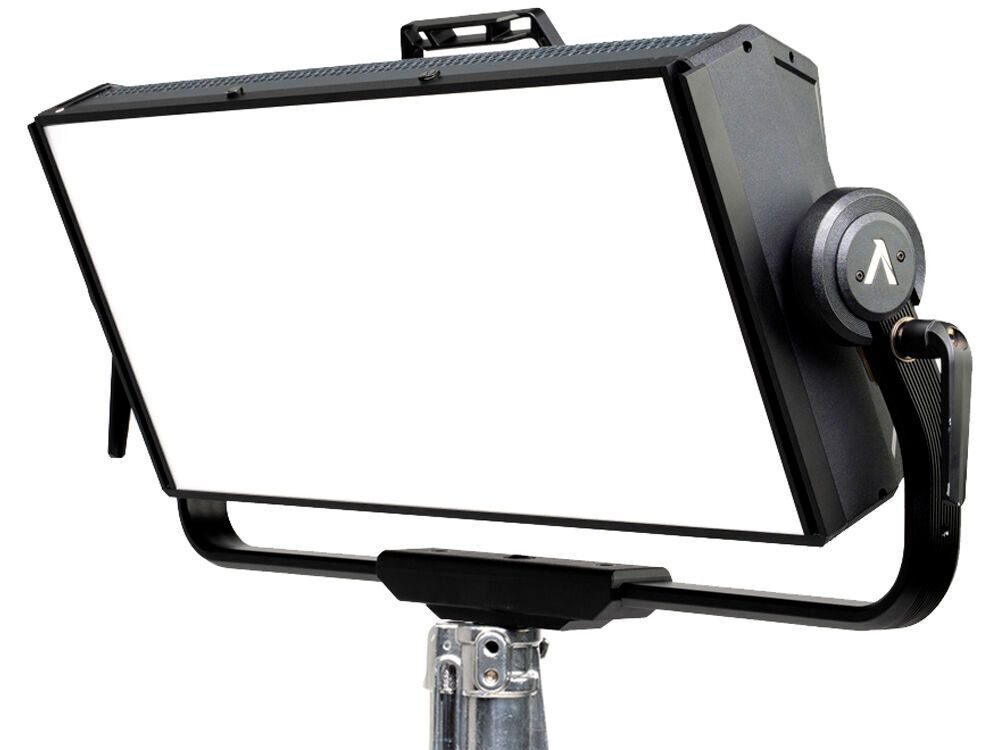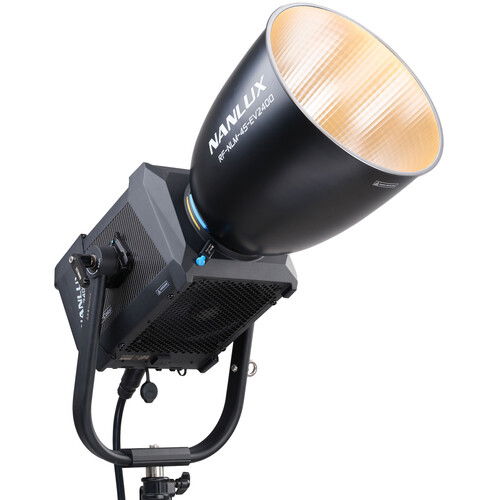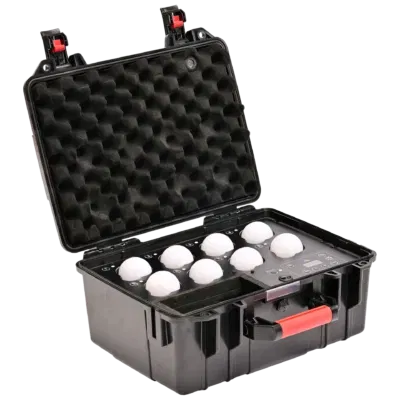The film industry has undergone a dramatic transformation with LED film lighting at its forefront. LED film lighting technology offers complete control over colour temperature, power efficiency, and versatility that traditional lighting sources can’t match. LED film lighting are essential tools of every Gaffers kit, transforming how cinematographers can approach both studio and location shoots.
In 2024, the current generation of LED film lighting pushes boundaries previously thought impossible, with high-output COB fixtures rivalling traditional HMI units and advanced panels exceeding broadcast colour standards. Innovative form factors, from flexible mats to programmable tubes, offer cinematographers new creative tools for crafting visual narratives. This comprehensive guide examines the latest professional LED lighting technology, exploring specifications, unique features, and practical applications across different fixture types.
Table of Contents
Understanding LED Technology in Film
At its core, LED (Light-Emitting Diodes) are semiconductors that convert electrical energy into light. Unlike traditional tungsten lights or HMI lights, LED technology produces minimal heat while maintaining high light output.

The semiconductor material used in professional LED film lighting undergoes rigorous quality control to ensure consistent colour rendering and long-term reliability. Advanced phosphor coatings and precision manufacturing contribute to the high standards required for professional cinematography.
| Type | Description |
| RGBW | Includes an additional white LED for colour accuracy and white lighting options |
| RGBWW | Features a warm white LED in additional to RGB LEDs for software white light |
| RGBCW | Combines RGB LEDs with a separate cold white LED for versatile color white options |
| RGBCCT | Includes RGB LEDs, cold white LED and warm white LED for a full spectrum of colours |
| RGBIC | RGB LEDs with individual control fro intricate colour patterns and effects |
| ARRI Spectra Colour Engine | RGBLCA (Red, Green, Blue, Lime, Cyan, Amber) Improved Skin Tone, Better Tungsten Matching and Red Saturation |
| Rotolight SpectroLED | RGBWM (Red, Green, Blue, Warm White, Mint Green) |
| Nanlite FM Colour | RGBAWC (Red, Green, Blue, Amber, Warm White, Cool White) |
| Creamsource Spectrum | RGBALW (Red, Green, Blue, Amber, Lime, Cool White) |
| Other Colours | Include Yellow, Magenta, Royal Blue, Deep Red |
LED film lighting incorporates sophisticated colour science to achieve high Colour Rendering Index (CRI) ratings above 95, with advanced phosphor coatings and multi-chip arrays expanding beyond basic RGB mixing. Modern fixtures utilise additional colour channels – including mint green, cyan, and deep red – to enhance skin tones, match traditional light sources, and provide precise control across the visible spectrum.

Professional LED Lighting Equipment
LED Panels
LED panel technology has changed alot since its professional debut in 2007 with the Litepanel 1×1, evolving from Daylight panels into sophisticated lighting ecosystems. While early panels struggled with colour accuracy and limited output, modern fixtures deliver exceptional performance with up to 4000 lux at 3 meters and CRI/TLCI ratings exceeding 98. Advanced colour engines now incorporate six or more channels, including specialised wavelengths like mint green and deep red, enabling precise reproduction of skin tones and traditional light sources. This technological leap has established LED panels as primary lighting tools across the industry, from independent productions to major studio features.
ARRI Skypanel X
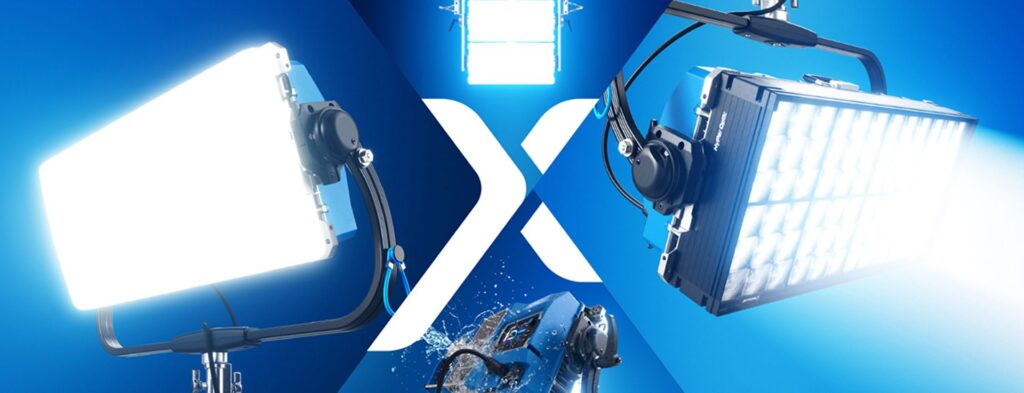
Specifications:
- Output: 1,590 lux (X21 with standard diffuser) to 53,300 lux (X21 with Hyper Optic) at 3 meters
- Color Range: 2,800K-10,000K
- CRI/TLCI: 98+
- Power Draw: 960W
- CCT Tolerance: ±100K
Features:
- Lighting Effects Library with 17 customizable effects
- SkyOS 2.0 with enhanced color control
- HDR recording compensation
- Weather resistance (IP54)
- Calibrated color space conversion
- Real-time DMX mapping
Aputure Nova P600C
Specifications:
- Output: 2000 lux at 3 meters
- Color Range: 2300K-10000K
- CRI/TLCI: 95+/98+
- Power Draw: 600W
- CCT Tolerance: ±200K
Features:
- Sidus Link app control
- Built-in effects engine with 11 lighting effects
- Hyper Reflector Technology
- LumenRadio CRMX compatibility
- Pixel-level control zones
- IP53-rated weather resistance
Rotolight Titan X2

Specifications:
- Output: 2700 lux at 3 feet
- Color Range: 3000K-10000K
- CRI: 96+
- Power Draw: 180W
- CCT Tolerance: ±50K
Features:
- TouchScreen interface
- SmartSoft™ electronic diffusion
- High-speed sync flash
- RGBWW SpectroLED™ engine
- 1300+ digital filters
- True Aperture Dimming™
Creamsource Vortex8
Specifications:
- Output: 4000 lux at 3 meters
- Color Range: 2200K-15000K
- CRI/TLCI: 95+/97+
- Power Draw: 650W
- CCT Tolerance: ±100K
Features:
- Advanced CreamOS architecture
- Parallel effects engine
- Raw narrow beam technology
- IP65 rating for all-weather use
- Six-zone pixel mapping
- Integrated power supply
LED COB (Chip-on-Board)
COB (Chip-on-Board) technology emerged in professional film lighting around 2017, with Aputure’s 300d. This technology placed multiple LED dies directly onto a single substrate, creating a more concentrated light source that could be precisely focused using traditional optical systems.
COB technology improves over traditional LED by eliminating multiple shadow effects and providing superior optical control. The concentrated light source enables precise beam shaping through Fresnel lenses and other modifiers, while maintaining the benefits of LED technology. These fixtures have offered HMI-comparable output with the added advantages of instant strike, silent operation, RGB (Red, Green, Blue) and CCT (Correlated Colour Temperature) control using wireless digital control systems.
Aputure Storm XT26

Specifications:
- Output: 128,000 lux at 3 meters
- Color Range: 2700K-6500K
- CRI/TLCI: 96+/98+
- Power Draw: 2600W
- Beam Angle: 15-45 degrees
Features:
- Hybrid Active Cooling System
- IP54 weather resistance
- LumenRadio CRMX built-in
- Bowens mount compatibility
- App-based pixel effects engine
- Weatherproof controller box
Nanlux Evoke 2400B
Specifications:
- Output: 107,000 lux at 3 meters
- Color Range: 2700K-20000K
- CRI/TLCI: 96+/97+
- Power Draw: 2400W
- Beam Angle: 15-60 degrees
Features:
- Raw LED technology
- Built-in color gel library
- Environmental temperature monitoring
- Electronic ballast with PFC
- Silent mode operation
- Multi-voltage operation (100-240V)
ARRI Orbiter
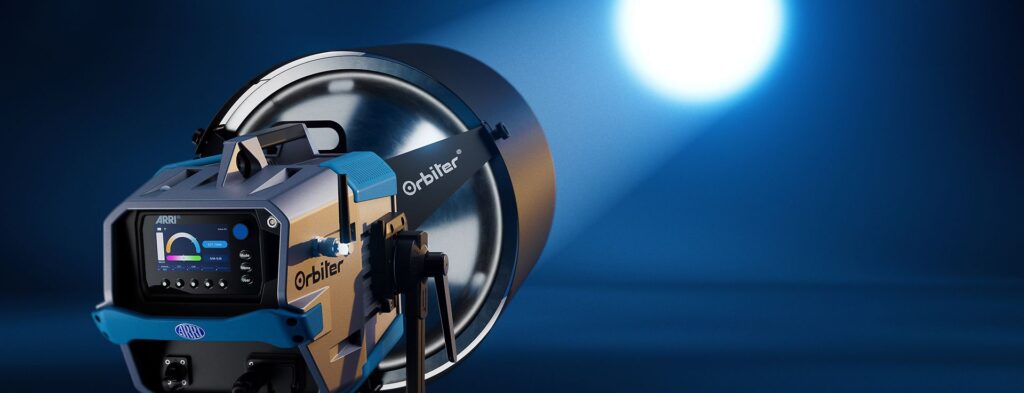
Specifications:
- Output: 18,000 lux at 3m (Open Face 15°)
- Color Range: 2000K-20000K
- CRI: 98+
- Power Draw: 400W
- CCT Tolerance: ±50K
Features:
- Interchangeable Quick Lighting Mount
- ARRI Spectra color engine
- Removable control panel
- Weather-resistant design
- Integrated color sensor
- Full NDI implementation
LED Tubes
LED tube technology gained momentum when Astera introduced the Titan Tube in 2017. The introduction of pixel-level control, wireless synchronisation, and high CRI ratings marked a turning point in their application. Modern tubes feature up to 16 individually controllable segments per unit, RGBW or RGBWW color mixing, and the ability to synchronise hundreds of units wirelessly for complex lighting effects.
The evolution continued with manufacturers like Digital Sputnik, Nanlite, and Aputure entering the market. By 2020, professional LED tubes incorporated sophisticated colour engines achieving CRI ratings above 96, battery operation exceeding 20 hours, and comprehensive effect engines. These developments expanded their role from simple practical sources to essential tools for creating dynamic lighting effects, background illumination, and primary lighting sources.
Astera Titan Tube

Specifications:
- Output: 2500 lumens
- Color Range: 1750K-20000K
- CRI/TLCI: 96+/95+
- Power Draw: 72W
- Length: 4 feet
Features:
- 16 individually controllable pixels
- Built-in battery (up to 20 hours)
- Wireless DMX/CRMX
- Titan Effect Engine
- AsteraApp compatibility
- Seamless daisy-chaining
Nanlite Pavotube II

Specifications:
- Output: 2800 lumens
- Color Range: 2700K-12000K
- CRI/TLCI: 95+/98+
- Power Draw: 30W
- Length: 4 feet
Features:
- 12 built-in practical effects
- Smartphone app control
- Multiple mounting options
- 0-100% stepless dimming
- Memory function
- Dual power options
Aputure Infinibar
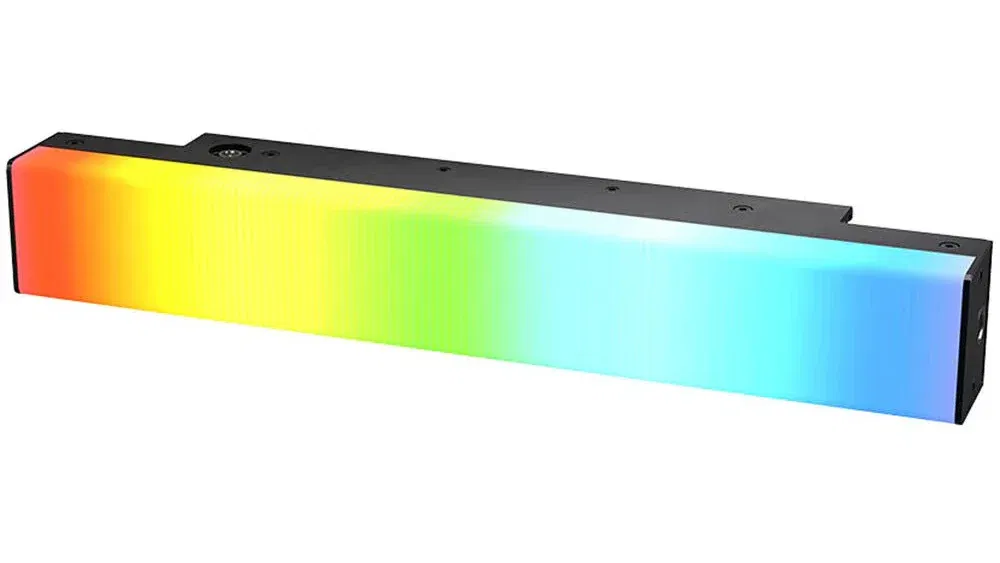
Specifications:
- Output: 3000 lumens per section
- Color Range: 2800K-10000K
- CRI: 96+
- Power Draw: 75W
- Length: 4 feet
Features:
- 480 individual control pixels
- Seamless connection system
- Advanced pixel mapping
- Wireless DMX control
- Multiple mounting configurations
- IP65 rating
LED Rope and Strip Lights
LED strip technology entered professional film lighting around 2014, with LiteGear pioneering the LiteRibbon series – the first professional-grade LED strips designed specifically for cinema applications. This marked a significant advancement from consumer-grade LED strips, introducing higher CRI ratings, dimming stability, and robust construction needed for professional production.
Aputure entered the market in 2023 with the Amaran SM5C. While LiteGear’s LiteRibbon established professional standards with various output options from 3W to 15W per foot and high CRI ratings, the SM5C brought new capabilities with 100 individually addressable RGBWW pixels, IP65-rated construction, and seamless corner connectors.
Aputure Amaran SM5C
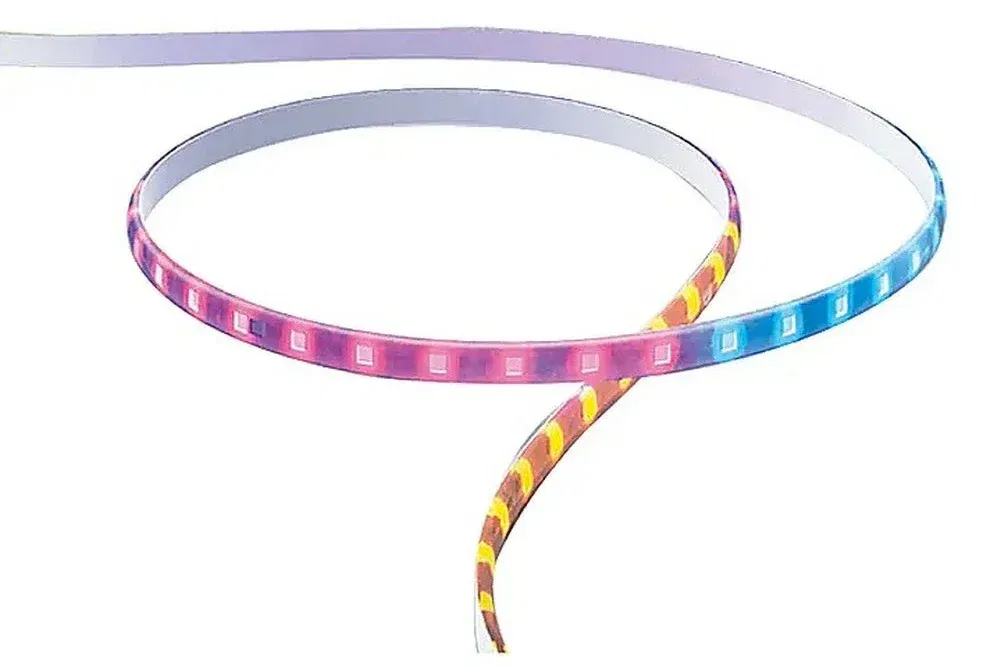
Specifications:
- Output: 1300 lumens per meter
- Color Range: 2500K-7500K
- CRI/TLCI: 95+/96+
- Power Draw: 75W
- Length: 5 meters
- Pixels: 100 per strip
Features:
- Individual pixel addressing
- IP65 weather resistance
- Sidus Link app integration
- 16 million colors
- Magnetic mounting system
- Custom effect creation
- Seamless corner connections
LiteGear LiteRibbon

Specifications:
- Output: Variable (3W-15W per foot)
- Color Range: 2000K-10000K (Hybrid)
- CRI: 95+
- Power Options: 12V/24V
- Custom length options
Features:
- Hybrid color mixing
- Field-cuttable design
- Multiple density options
- Removable diffusion
- Spectrum color mixing
- VHO (Very High Output) options
The professional LED strip market continues to innovate with enhanced control systems and improved durability. These fixtures prove invaluable for creating sophisticated lighting effects while maintaining the professional standards required for high-end production.
LED Bulbs
Professional LED bulbs gained momentum in 2019 when Astera introduced the NYX Bulb, bringing intelligent wireless control to the traditional bulb format. Aputure introduced the B7c in 2020, which established new standards for color accuracy and mobile app-based control in an E27 form factor. Nanlite followed with their PavoTube Ball 6C, while Godox introduced their FL60 series.
Modern professional LED bulbs merge familiar household fitting with advanced features – colour temperatures from 2000K-10000K, full RGB mixing capabilities, and extended battery operation. With high CRI ratings above 95, wireless DMX control, and Bluetooth synchronisation through platforms like AsteraApp and Sidus Link, these fixtures now serve as powerful tools for Cinematographers requiring more control over practical lighting sources.
Aputure B7C
Specifications:
- Output: 720 lumens
- Color Range: 2000K-10000K
- CRI/TLCI: 95+/96+
- Power Draw: 7W
- Battery Life: 10 hours
- Socket: E26/27
Features:
- Sidus Link wireless control
- 10 lighting effects
- HSI color mode
- Music mode
- Multi-fixture grouping
- Battery power monitoring
Astera LunaBulb
Specifications:
- Output: 800 lumens
- Color Range: 1750K-20000K
- CRI: 96+
- Power Draw: 10W
- Battery Life: 20 hours
- Socket: E27
Features:
- AsteraApp integration
- CRMX wireless DMX
- Bluetooth mesh networking
- Effect synchronization
- Impact-resistant construction
- Auto-sensing power modes
LED Mats and Flex Panels
Flexible LED technology emerged in the film industry around 2016 when LiteGear introduced their LiteMat series, changing how cinematographers approach lighting in tight spaces. The technology saw advancement when Aladdin Lights entered the market in 2019 with their ALL-IN and BI-FLEX series, followed by Aputure’s entry into the flexible panel market with the Amaran Infinimat in 2023. with improved portability and colour accuracy.
Today’s professional LED mats combine ultra-thin profiles (often less than 5mm) with features like hybrid power options, pixel-level dimming, and advanced colour mixing engines. All modern LED lite mats / flex panels delivers improved output while maintaining precise colour control across 2000K-10000K range, pixel mapping and 98+ CRI ratings. The integration of RGBWW technology and specialised diffusion layers enables these fixtures to produce soft, even illumination.
Aputure Amaran Infinimat
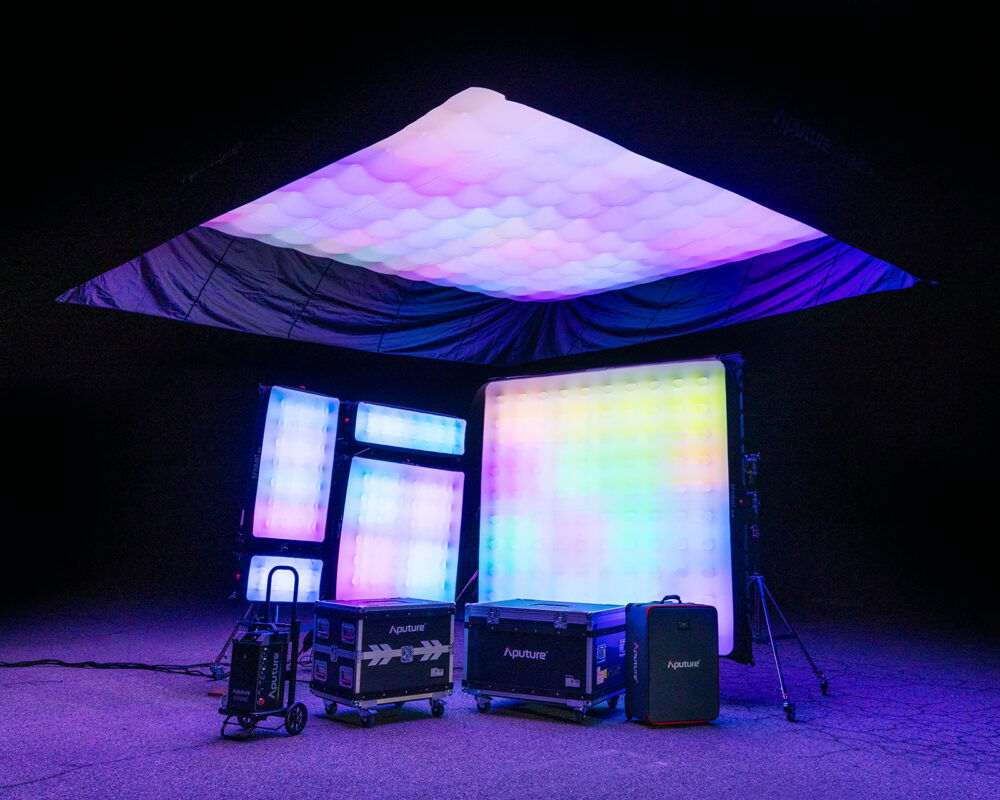
Specifications:
- Output: 4000 lumens
- Color Range: 3200K-6500K
- CRI/TLCI: 95+/96+
- Power Draw: 200W
- Thickness: 4.5mm
Features:
- Ultra-thin design
- Multiple mounting options
- Integrated diffusion
- Silent operation
- Custom frame system
- Dual power options
Aladdin Mosaic Pixel

Specifications:
- Output: 2000 lumens
- Color Range: 2000K-12000K
- CRI: 98+
- Power Draw: 100W
- Pixels: 400 individual
Features:
- Individual pixel mapping
- DMX/RDM control
- Built-in effects engine
- Fabric-integrated design
- Wireless synchronization
- Impact-resistant construction
LiteGear LiteMat Spectrum 2
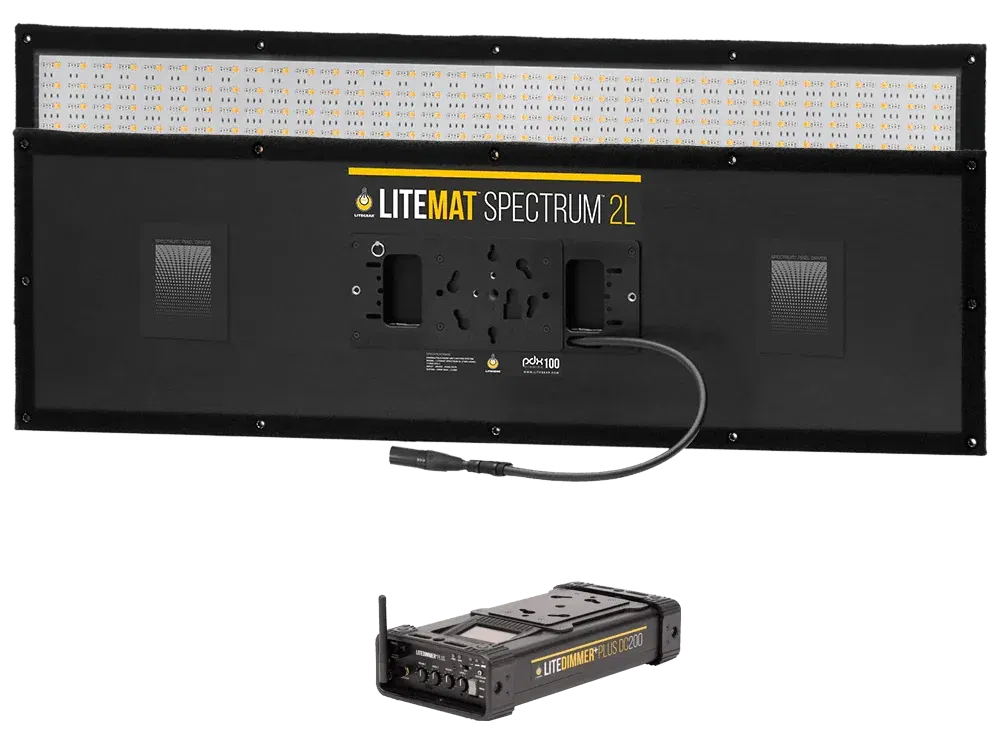
Specifications:
- Output: 4500 lumens
- Color Range: 2000K-10000K
- CRI: 95+
- Power Draw: 200W
- Dimming: 0-100%
Features:
- Spectrum color engine
- Hybrid power design
- Ultra-thin profile
- Multiple mounting options
- Advanced color mixing
- Impact-resistant edge protection
Technical Considerations and Applications
Power Management
LED film lighting consumes significantly less power than traditional lighting while delivering increased output. The Aputure Storm XT26 draws just 2600W (3500W maximum) to match a 4000W HMI’s output, or 12,000W Tungsten, while 40W LED panels produce light levels equivalent to 200W fluorescent fixtures. This efficiency extends across all categories, with 10W LED Bulbs effectively replacing 60W traditional incandescent bulb while offering precise colour control and reduced heat.
Battery technology in LED film lighting has changed our approach to location shooting. Modern fixtures support multiple power options, from AC mains to professional battery systems like V-Lock, Gold Mount and NP-F. Advanced units feature intelligent power management – the Aputure Nova P600c automatically adjusts output to available power, while ARRI Skypanels incorporate load-sharing across multiple batteries. These systems typically achieve 2-3 hours of full-power operation on standard 230Wh batteries.
Modern LED film lighting control systems provide detailed power monitoring. Features like Litepanels’ SmartPower and ARRI’s Power Management System offer real-time data on consumption rates, remaining runtime, and system status across multiple units. Protection circuits guard against common issues like voltage fluctuations and power surges, while load balancing ensures consistent performance when switching between power sources.
Colour Control and Consistency
Professional LED fixtures now match the color accuracy of traditional tungsten sources at a fraction of the power draw. Digital controls enable instant adjustments without gels or filters, while built-in presets facilitate common lighting scenarios and gel manufacturers. Color calibration tools ensure consistency across multiple units, critical for maintaining consistency on large lighting setups.
Modern fixtures accurately render both subtle skin tones and saturated colours from 100% down to 0.1% intensity. Color consistency remains stable even at extreme temperatures, from -20°C to +45°C, eliminating the variation common in earlier LED systems.
Control over colour temperature, typically ranging from 2000K to 10,000K, along with RGB. Colour management systems include CCT (Correlated Colour Temperature), HSI (Hue, Saturation, Intensity) control and preset library (Police, Broken light, Fire, Fireworks). These capabilities allow cinematographers to quickly match practical lighting conditions or create specific moods.
| Fixture set to Daylight | Average CRI | Extended CRI |
| Arri SkyPanel X21 | 96.9 | 95.58 |
| Creamsource Vortex8 | 96.2 | 94.24 |
| Rotolight Titan X2 | 96.8 | 95.21 |
| Arri Skypanel S60-C | 95.7 | 92.92 |
| Litepanels Gemini 2×1 | 95.2 | 93.24 |
| Sunnyxiao Caster C02P | 95.4 | 92.83 |
| Luxli Taiko | 97.6 | 95.8 |
| Rayzr MC Max 400 | 95.3 | 92.96 |
| Fixture set to Tungsten | Average CRI | Extended CRI |
| Arri SkyPanel X21 | 97.7 | 97.34 |
| Creamsource Vortex8 | 97.1 | 95.82 |
| Rotolight Titan X2 | 95.9 | 94.27 |
| Arri Skypanel S60-C | 96.1 | 94.06 |
| Litepanels Gemini 2×1 | 97.2 | 95.3 |
| Sunnyxiao Caster C02P | 95.3 | 93.78 |
| Luxli Taiko | 97.7 | 96.8 |
| Rayzr MC Max 400 | 90.6 | 88.64 |
Modifiers and Light Shaping
LED fixtures work with both traditional and specialized light-shaping tools. The DoPchoice SNAPBAG® system mounts directly to fixtures like the Aputure 600d Pro and ARRI Skypanel, providing 90% light transmission while maintaining consistent color temperature. Their SNAPGRID® technology offers 20°, 30°, and 40° beam control options, eliminating spill without the light loss common in traditional eggcrates.
Softbox technology has evolved specifically for LED characteristics. Chimera’s LED POP Bank series features silver-lined interiors that increase output by 40% compared to white interiors. The DoPchoice Octa 5′ achieves a near-perfect wrap-around light through its octagonal design and double-diffused surface, while maintaining a compact 18-inch depth. Aputure’s Light Dome SE series combines tool-free speed rings with their Amplifier Lens technology, increasing output by 118% compared to standard diffusion.
Professional light control systems now include sophisticated options. The ARRI Orbiter’s Light Shaping Kit converts from open face to Fresnel through its Variable Beam Spread system, offering precise control from 15° to 65°. Prolycht’s Hyperspace system provides continuous zoom from spot to flood while maintaining consistent color quality. Rosco’s DMG DASH series features snap-on intensifiers that boost output by 200% when needed, while their Mix diffusion materials specifically address LED color rendering.
Creative Applications
Studio Production
Traditional Hollywood sound stages running tungsten lighting draw between 3,000-5,000 amps per day, consuming approximately 24,000-40,000 kWh weekly. In contrast, modern LED systems operate on significantly reduced infrastructure, drawing just 400-800 amps daily. Warner Bros. Studios cut power consumption by 75% after converting to LED, while Universal’s Stage 28 reduced requirements from 2,400A to 400A, Netflix Los Angeles stages average 600A per day with LED lighting and Sony Pictures Stage 6 reduced generator requirements from three 1200A units to a single 800A unit after converting to LED.
Professional LED film lighting systems rely on DMX512 protocol, where one universe controls 512 individual parameters. A single ARRI Skypanel requires up to 23 DMX channels to manage intensity, color, effects, and zoom – meaning a typical studio setup with 20 Skypanels consumes nearly an entire universe. Art-Net solves this limitation by converting DMX data to travel over standard Ethernet networks, handling up to 32,768 universes through a single Cat5e/6 cable. LumenRadio’s CRMX technology wirelessly transmits DMX data with just 5ms latency, using automated frequency hopping between 2.402-2.480 GHz to avoid interference. Major manufacturers including Astera, Aputure, and ARRI integrate CRMX receivers directly into their fixtures, enabling reliable wireless control without signal degradation.
Virtual production merges real-time rendered environments with traditional cinematography, requiring precise synchronization between LED volumes and practical lighting. Modern fixtures communicate directly with game engines through NDI and sACN protocols, enabling frame-accurate color matching between practical sources and LED walls. Color calibration systems maintain consistency across both elements, while DMX-based effects engines synchronize with timecode and media servers, allowing unified control of the entire lighting setup through a single operator.
Location Shooting
Location lighting has evolved through advanced LED technology. IP65 and IP68-rated fixtures ensure reliable operation in extreme conditions – from desert dust storms to tropical downpours. Unlike traditional HMI units requiring warmup and cool-down periods, LED fixtures strike instantly at full power and can be safely adjusted while running. This combination of weatherproofing and operational flexibility allows crews to react quickly to changing conditions without compromising light quality.
Power management for LED film lighting on location has simplified significantly. Compact inverter generators running at 2800W power multiple high-output fixtures while operating at just 52-58 dB, enabling placement closer to set without audio interference. Professional 14.4V battery systems (V-Lock/Gold Mount) ranging from 98Wh to 293Wh power individual fixtures up to 20A. Modern LED fixtures draw significantly less power than traditional units – a 2600W LED fixtures is equivalent to a 4000W HMI unit.
The lightweight nature of LED fixtures, combined with simplified power needs, means smaller teams can efficiently manage complex lighting setups. For smaller shoots, a dedicated generator operators and extensive power distribution crews are no longer required. A single technician can now handle a smaller generator, along with multiple battery-powered units. This streamlined approach allows productions to work faster, access challenging locations, and maintain high production values with minimal crew.
Future Developments and Industry Impact
The evolution of LED film lighting continues with emerging technologies promising greater efficiency and control. Advances in semiconductor material development suggest future improvements in both output and color accuracy. Integration with wireless control systems and smart technologies points toward increasingly sophisticated lighting management possibilities.
Research into new phosphor compositions and optical designs promises even better color rendering capabilities. Development of more efficient power management systems will further extend battery life for portable units. Increased integration with virtual production tools will enhance the capabilities of LED technology in modern filmmaking.
As LED film lighting technology matures, its role in modern cinematography becomes increasingly central. From independent productions to major studios, the impact on visual storytelling continues to grow. Understanding both technical foundations and creative applications remains essential for maximizing this powerful technology’s potential.
Industry Standards and Best Practices
Film and broadcast industries have established rigorous LED film lighting testing standards under TLCI-2012 and IES TM-30-20 protocols. TLCI (Television Lighting Consistency Index) specifically evaluates LED performance with digital cinema cameras, measuring how sensors interpret color across 24 sample patches. Professional fixtures must achieve minimum TLCI ratings of 85, with high-end units exceeding 95. Beyond traditional CRI measurements, the IES TM-30-20 protocol examines 99 color samples to verify gamut handling and color fidelity.
Modern testing protocols measure several critical performance aspects. SSI (Spectral Similarity Index) quantifies how closely LED sources match reference illuminants like daylight or tungsten. LED fixtures must maintain consistent spectral output from 0-100% intensity, with color temperature drift limited to ±100K. Testing includes frame rates from 10-120fps at various shutter angles to ensure flicker-free operation. High-speed cameras detect potential PWM (Pulse Width Modulation) artifacts that might affect slow motion footage.
While LED technology continues to advance, HMI fixtures remain essential for high-powered lighting applications. Current LED fixtures max out around 1200W-2400W, equivalent to a 4/5K HMI, falling short of the raw output needed to compete with 9K, 12K, and 18K HMI units. These powerful HMI fixtures remain crucial for large-scale exterior lighting, creating artificial sunlight, and illuminating large areas for night scenes where throw distance and output are paramount.
Cost Considerations and ROI
Initial hardware costs for LED film lighting vary significantly across lighting technologies. Professional LED fixtures command premium prices ($5,000-15,000), compared to tungsten units ($500-2,000) and HMI fixtures ($3,000-8,000). However, operational costs reveal stark differences – a 2K tungsten bulb costs $30 and lasts 200 hours, while a 1.2K HMI bulb costs $600 and runs 500 hours. LED fixtures operate 50,000+ hours before requiring service, eliminating regular lamp replacement costs. A stage using ten 2K tungsten fixtures typically requires $3,000 annually in bulb replacements alone.
Power consumption presents the most significant cost difference. A 400W LED fixture matching a 2K tungsten saves 1600W per hour in direct power, while also reducing HVAC demands by 30-40% due to decreased heat output. Studios report 60-75% reductions in total power consumption after converting to LED systems. Traditional lighting requires additional infrastructure – dimmers ($2,000-5,000 per rack), power distribution ($3,000-10,000 per stage), and increased electrical service capacity. LED fixtures operate on standard circuits, eliminating these auxiliary costs.
Production companies report substantial savings in air conditioning costs due to reduced heat output. The elimination of frequent bulb replacements reduces both maintenance expenses and production downtime. Additional savings come from reduced power distribution infrastructure requirements.
Conclusion
LED technology has established new standards in LED film lighting, offering unprecedented colour control, power efficiency, and operational flexibility. Modern fixtures achieve exceptional colour accuracy with TLCI ratings above 95 and precise temperature control from 2800K-10000K. However, traditional HMI fixtures remain essential for high-powered applications, with 9K, 12K, and 18K units providing output levels currently unattainable by LED technology.
The financial implications of LED adoption reflect this technological advancement. While professional LED fixtures command higher initial investments ($5,000-15,000), operational costs favor LED systems through reduced power consumption (60-75% savings), eliminated lamp replacement, and simplified infrastructure requirements. These savings, combined with 50,000+ hour lifespans, typically return investments within 12-18 months of regular use.
Contemporary cinematography demands understanding both LED fixtures and traditional lighting tools. While LED film lighting excels in control, efficiency, and colour accuracy, practical limitations with high-powered outputs ensure HMI sources remain crucial for specific applications. This ongoing improvements in LED performance, provides cinematographers with an expanding toolkit for efficient, precise control over their lighting designs.
Links
Can you explain how LED lights function in simple terms?
LED (Light Emitting Diode) technology converts electrical energy directly into light through a process called electroluminescence. When electrical current passes through a semiconductor chip, it causes electrons to release energy in the form of photons (light). Professional LED fixtures incorporate sophisticated heat sinks and thermal management systems to maintain optimal operating temperature, ensuring consistent performance and long operational life. This direct conversion of electricity to light makes LEDs significantly more efficient than traditional lighting sources.
What does a basic cinema lighting setup consist of?
Professional cinema lighting begins with a three-point arrangement using specific fixtures for each role. The key light often utilizes a larger LED panel or COB fixture with precise beam control and color accuracy. Fill lights typically employ softer sources like LED panels with diffusion, while backlights might use more focused fixtures like LED Fresnels. Modern LED technology allows all three lights to maintain consistent color temperature while offering individual control over intensity and spread, enabling precise adjustment of contrast ratios and mood.
How do I choose the right LED fixtures for professional production?
Select professional LED fixtures based on several key criteria: Color accuracy (CRI above 96), flicker-free operation at all frame rates, consistent color temperature throughout the dimming range, and robust DMX control capabilities. Consider power requirements for your typical shooting scenarios, including battery operation needs for location work. Evaluate fixture build quality, especially mounting options and weather resistance for outdoor use. Professional-grade equipment should include comprehensive warranty coverage and manufacturer support.
What power considerations are important for LED lighting setups?
Professional LED lighting requires careful power management. Calculate total power draw including all fixtures and accessories, ensuring your electrical circuit can handle the load. Consider power factor ratings (should exceed 0.9) for efficient operation. For location work, evaluate battery options including voltage compatibility and runtime requirements. Modern LED fixtures typically offer multiple power options including AC input, battery power, and DC operation through specialised power stations.
How should I maintain my LED lighting equipment?
Professional LED fixtures require regular maintenance to ensure optimal performance. Clean optical surfaces and cooling vents monthly using appropriate cleaning solutions. Inspect power cables and connectors for wear or damage before each use. Test color accuracy and output levels quarterly using calibrated meters. Maintain detailed records of usage hours and any performance issues. Professional equipment should undergo annual manufacturer-recommended servicing to ensure continued reliability and performance.
What advanced features should I look for in professional LED lighting?
Professional LED fixtures should offer comprehensive DMX control, high-resolution dimming (16-bit minimum), and precise color temperature adjustment. Look for RDM capability for remote setup and monitoring. Evaluate wireless control options including protocol compatibility and range. Consider fixtures offering effects programming capabilities and synchronized operation for complex lighting designs. Advanced cooling systems and sophisticated colour mixing capabilities are essential for professional applications.
